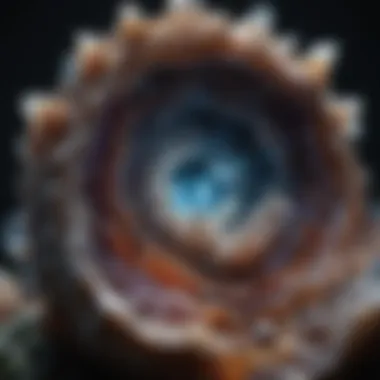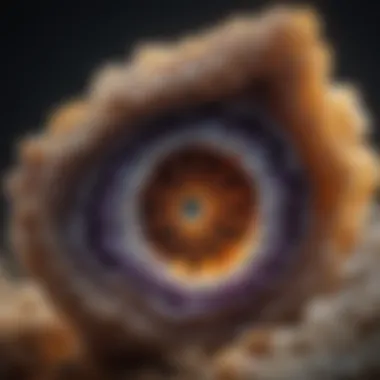Unveiling the Enigmatic Small Geodes: Marvels of Nature's Creation


Rock and Fossil Identification
Small geodes are intriguing geological formations, each telling a unique story of their formation and composition. These miniature wonders often hold a world of crystal-filled beauty within their unassuming exterior. The identification of small geodes requires a keen eye and an understanding of the key characteristics that set them apart from other rocks. Observing the outer texture, color patterns, and weight can provide initial clues to the hidden treasures within. From the smooth exterior to the mesmerizing crystalline structures nestled within, small geodes offer a glimpse into the wonders of geological history.
Collection Techniques and Strategies
Collecting small geodes can be a gratifying pursuit for enthusiasts seeking to expand their geological treasures. The best practices for collecting these miniature marvels involve researching prime locations where small geodes are found, whether in sedimentary rocks or volcanic formations. Time and patience are key components in the successful extraction of small geodes, requiring delicate tools to ensure the preservation of their delicate structures. Safety protocols should also be considered when excavating these geological gems from their natural habitat.
Preservation and Presentation Methods
Preserving small geodes allows for their beauty to stand the test of time, retaining their natural radiance and allure. Techniques such as drying, sealing, and careful storage help maintain the integrity of these delicate formations. Proper storage methods involve shielding small geodes from moisture and extreme temperatures, ensuring their longevity and preservation. When it comes to displaying these miniature treasures, creativity plays a vital role. From elegant glass cases to custom-designed shelves, there are various ways to showcase the intricate beauty of small geodes while safeguarding them from environmental elements.
Geological Insights and Scientific Significance
Small geodes provide valuable insights into geological formations and processes, offering clues to the earth's dynamic history. Beyond their aesthetic appeal, small geodes hold substantial scientific significance, shedding light on past environments and mineral crystallization processes. The historical importance of small geodes is evident in notable discoveries that have shaped our understanding of geological evolution. By exploring the depths of small geodes, researchers uncover a wealth of information that enriches our knowledge of the earth's intricate geological tapestry.
Introduction to Small Geodes
Small geodes, these mesmerizing geological marvels, captivate both amateur enthusiasts and seasoned geologists alike. In this immersive journey through the world of small geodes, we unravel the mysteries of these miniature natural treasures. Examining their formation, intricate characteristics, and vital significance in geology opens up a realm of knowledge seeped in scientific importance and aesthetic allure. Through this exploration, we aim to provide a comprehensive guide for rock and fossil collectors seeking to deepen their understanding of these fascinating geological formations.
Definition of Geodes
Geodes, in their essence, are geological formations that contain a cavity lined with crystals or other mineral matter. These captivating structures develop over time through a unique process that sets them apart from standard rock formations. Encountering a geode in its natural state reveals a world of sparkling crystals encapsulated within a humble exterior, showcasing nature's artistic brilliance in its purest form. Geodes come in various shapes and sizes, each holding a distinct charm that stems from their individual mineral composition and formation history.
Sizes of Small Geodes
Small geodes, in their miniature grandeur, vary in size from as small as a few centimeters to a few inches in diameter. These petite geological wonders offer a compact yet intricate display of crystal formations within their confines. The diversity in sizes presents collectors with a range of options to explore, from delicate palm-sized geodes to more substantial specimens that showcase elaborate crystal structures. Understanding the sizes of small geodes is crucial for enthusiasts looking to curate a well-rounded collection that highlights the nuances of these geological marvels.


Formation Process
The formation of small geodes is a complex and fascinating journey that begins with volcanic activity or sedimentary processes. Over time, mineral-rich water seeps into cavities within rocks, depositing layers of crystals that gradually grow to form the captivating interiors of geodes. The intricate interplay of geological conditions, such as temperature, pressure, and mineral saturation, dictates the size, shape, and quality of crystals within these unique formations. Studying the formation process not only unravels the geological history embedded within geodes but also offers insights into the Earth's dynamic mechanisms that shape our natural environment.
Significance in Geology
Geodes hold profound significance in the field of geology due to their intricate structures and mineral diversity. These geological wonders provide valuable information about past environments, mineral precipitation processes, and geological events that have shaped our planet over millions of years. Through the study of geodes, geologists gain insights into mineral formation, crystal growth mechanisms, and the geological conditions that foster the creation of these natural treasures. Unraveling the significance of geodes in geology opens doors to a deeper understanding of Earth's history and the forces that have sculpted its surface over millennia.
Characteristics of Small Geodes
In this section, we delve into the crucial aspects that define the essence of small geodes. Understanding the characteristics of these geological marvels not only enriches our knowledge but also sheds light on their significance in the world of geology. By examining the external appearance, internal structure, crystal formation, and mineral composition of small geodes, we unravel a fascinating narrative that showcases the intricate beauty and scientific importance encapsulated within these miniature natural wonders.
External Appearance
The external appearance of small geodes is a key aspect that captivates collectors and geology enthusiasts alike. These spherical or oblong formations can vary in size, ranging from a few centimeters to larger, more imposing specimens. Their outer surface often displays unique patterns, colors, and textures, offering clues to the minerals and crystals hidden within. Remarkably, some small geodes exhibit exquisite crystalline formations on their exterior, hinting at the treasures concealed inside.
Internal Structure
Exploring the internal structure of small geodes unveils a mesmerizing world of intricate formations and hidden surprises. Upon cracking open a geode, one is greeted with a cavity lined with stunning crystal clusters. These crystals form over millions of years, layer by layer, creating breathtaking displays of natural artistry. The inner walls of a geode may shimmer with various hues, reflecting the mineral composition within and adding to the allure of these geological wonders.
Crystal Formation
The process of crystal formation within small geodes is a testament to the patience of nature and the intricate forces at play. As mineral-rich solutions seep into the cavities of rocks or sediments, they slowly crystallize over time, giving rise to the dazzling arrays of crystals found within geodes. Factors such as temperature, pressure, and mineral content influence the size, shape, and color of the crystals, resulting in the diverse and captivating formations that grace the interiors of these natural marvels.
Mineral Composition
The mineral composition of small geodes encompasses a wide range of elements and compounds that contribute to their unique properties. Common minerals found within geodes include quartz, calcite, amethyst, and agate, each lending its distinct characteristics to the overall appeal of the geode. Understanding the mineral composition not only enhances our appreciation for these geological formations but also provides valuable insights into the geological processes that shaped them.


Popular Locations for Finding Small Geodes
Small geodes have captivated the interest of rock and fossil collectors worldwide due to their unique formation and exquisite beauty. The search for these geological treasures often leads enthusiasts to various renowned geode-producing regions scattered across the globe. Exploring these popular locations offers not only the thrill of discovery but also a chance to appreciate the geological diversity present in different parts of the world.
Famous Geode-Producing Regions
When it comes to famous geode-producing regions, few places rival the prolific geode deposits found in Mexico, specifically in Chihuahua and Coahuila. These regions are renowned for their stunning amethyst geodes, which exhibit a breathtaking symphony of deep purples and violets, captivating collectors with their natural allure. Additionally, the Keokuk region in Iowa, USA, is another hot spot for geode hunters, known for its quartz and calcite-filled geodes that adorn collections with their remarkable clarity and structural complexity.
Tips for Geode Hunting
For aspiring geode hunters, patience and persistence are key virtues. Start by researching known geode-rich areas to increase the likelihood of a successful hunt. Look for signs of mineral deposits and sedimentary rock formations, as geodes are often found in association with these geological features. When out in the field, equip yourself with sturdy shoes, a rock hammer, a chisel, and safety goggles to ensure a safe and fruitful collecting experience.
Tools of the Trade
To enhance your geode-hunting expedition, it is essential to have the right tools at your disposal. A reliable crack hammer or rock pick allows you to break open geodes with precision, revealing their hidden crystalline treasures. A chisel and a pointed-tip rock hammer aid in extracting delicate specimens without causing damage. Additionally, a sturdy backpack, gloves, and protective gear ensure a comfortable and secure geode-collecting adventure.
Collecting and Preserving Small Geodes
Small geodes are not just geological specimens but treasures from nature intricately formed over time. The process of collecting and preserving small geodes is crucial in maintaining their beauty and scientific value. When embarking on a geode collection journey, it is essential to approach it with respect for the environment and the natural formations being collected. Ethical practices involve obtaining geodes from legal areas and not disrupting ecosystems. By adhering to ethical collection practices, collectors contribute to the preservation of geological sites and ensure the sustainability of geode formations for future generations to appreciate. Understanding the significance of ethical collection practices enhances the overall experience of geode hunting, enriching the connection between collectors and the natural world.
Ethical Collection Practices
Ethical collection practices play a pivotal role in the sustainability of small geode deposits and environmental conservation. By following ethical guidelines, collectors can make responsible choices that minimize negative impacts on geological sites. This includes obtaining necessary permits, respecting property rights, and leaving the natural habitat undisturbed. Legal compliance and environmental awareness are fundamental aspects of ethical geode collection. Additionally, engaging with local communities and geological authorities can provide valuable insights into the best practices for sustainable collecting. Overall, ethical collection practices not only protect delicate geode formations but also contribute to the larger ecosystem's well-being.
Cleaning and Displaying Techniques
Once small geodes are collected, proper cleaning and displaying techniques are essential to showcase their beauty and uniqueness. Cleaning geodes should be approached with care to avoid damaging the delicate crystal formations inside. Utilizing gentle cleaning methods such as using a soft brush or mild cleaning solutions can help maintain the geode's integrity. Displaying small geodes effectively involves considering factors like lighting, positioning, and protection from external elements. By carefully curating a display, collectors can highlight the aesthetic qualities of geodes while preserving their structural integrity. Through thoughtful cleaning and displaying techniques, small geodes can be transformed into striking natural art pieces that captivate beholders.


Storage Recommendations
Storing small geodes correctly is vital to prevent damage and preserve their quality over time. Geodes should be stored in a cool, dry place away from direct sunlight to avoid discoloration or deterioration. Using protective padding or individual containers can prevent scratches or breakage during storage. Proper ventilation is also essential to prevent moisture buildup, which can damage the mineral integrity of geodes. Implementing regular checks and maintenance of stored geodes ensures their long-term preservation. By following effective storage recommendations, collectors can safeguard their precious geode specimens and enjoy their beauty for years to come.
Scientific Research and Small Geodes
Scientific research on small geodes plays a crucial role in unveiling their enigmatic characteristics and geological significance. By delving into the microscopic world of these miniature geological formations, researchers can unravel the intricate processes that lead to their formation. The scientific community views small geodes as treasure troves of information, providing valuable insights into the geological history of an area. Through advanced analytical techniques, such as X-ray diffraction and electron microscopy, scientists can identify the mineral composition of small geodes with precision. This meticulous approach enables researchers to decipher the unique crystal formations within these geological marvels, shedding light on their remarkable beauty and scientific importance.
Geological Studies
Geological studies focusing on small geodes offer a deeper understanding of their formation and distribution patterns. Geologists analyze the geological context in which these small geodes are found, uncovering clues about the ancient processes that shaped these natural wonders. By examining the surrounding rock formations and sedimentary layers, researchers can piece together the geological history of the area. Geological studies also help in identifying the environmental conditions conducive to small geode formation, including factors like mineral saturation and temperature fluctuations. Through field surveys and laboratory analyses, geologists can create geological maps highlighting the occurrence of small geodes, aiding in both scientific research and recreational geode hunting.
Historical Significance
The historical significance of small geodes traces back to ancient civilizations, where these geological formations held mystical and ornamental value. Small geodes were revered for their striking appearance and believed to possess metaphysical properties. In various cultures, these miniature crystal caves were considered sacred, often used in ceremonial rituals. Over the centuries, small geodes have been collected and treasured as rare natural artifacts, showcasing the enduring fascination humans have had with these miniature geological wonders. Exploring the historical significance of small geodes offers a glimpse into the intersection of nature and culture, highlighting the transcendent appeal these geological marvels have held throughout history.
Contribution to Mineralogy
Small geodes make a significant contribution to the field of mineralogy by serving as microcosms of mineral formation and crystal growth. Studying the mineral composition of small geodes provides valuable insights into the physical and chemical processes that govern crystal formation. Mineralogists utilize small geodes as natural laboratories to investigate the nucleation and growth of crystals under varying geological conditions. By expanding our knowledge of crystallography and mineral behavior, small geodes contribute to the broader understanding of geological processes and the Earth's mineral diversity. The intricate structures and mineralogical diversity found within small geodes offer a wealth of information for mineralogists and geologists alike, shaping our understanding of the mineral kingdom.
Small Geodes in Popular Culture
Small Geodes in popular culture play a crucial role in shaping artistic expressions and symbolic meanings in various creative realms. Their unique aesthetic appeal and geological significance often inspire artists, writers, and filmmakers to incorporate them into their work. Small Geodes symbolize hidden beauty, mystery, and geological wonders, adding layers of depth to artistic creations. Artists draw inspiration from the intricate patterns and sparkling crystals found within geodes, translating their beauty onto canvas or sculptures. Writers often use geodes as metaphors for hidden treasures or profound discoveries in their literary works, infusing narratives with symbolic meanings that resonate with readers. In films, geodes make occasional appearances as mystical objects or symbols of rare beauty and inner worth, adding a touch of enchantment to cinematic storytelling. Overall, Small Geodes in popular culture serve as a rich source of inspiration for creative minds across various artistic mediums.
Artistic Inspirations
Artists have long been captivated by the enchanting allure of small geodes, finding inspiration in their crystalline structures and vibrant colors. The internal beauty of a geode, with its intricate patterns and sparkling crystals, serves as a muse for painters, sculptors, and other visual artists. Many artists aim to capture the essence of a geode's interior through intricate designs or abstract interpretations that reflect the natural beauty of these geological wonders. Some artists even experiment with incorporating actual geode fragments into their artworks, creating mixed-media pieces that blur the line between nature and art. The unique patterns and textures found in small geodes offer a visual feast for artists seeking to explore the complexities of natural formations through creative expression.
Symbolism and Meanings
Small Geodes hold symbolic meanings that resonate across cultures and traditions, representing hidden beauty, inner strength, and the discovery of treasures within. The hollow cavity of a geode, lined with crystals that slowly grow over time, symbolizes the potential for beauty to emerge from emptiness and darkness. Geodes are often seen as metaphors for the journey of self-discovery and personal growth, where inner beauty and resilience shine through adversity and challenges. In different belief systems, geodes are valued for their ability to enhance spiritual connections and promote positive energy within a space. Symbolizing both resilience and hidden potential, small geodes invite individuals to explore beneath the surface and discover the beauty that lies within themselves and the world around them.
Geodes in Literature and Film
The presence of small geodes in literature and film adds a touch of mystique and wonder to storytelling, creating rich tapestries of symbolism and intrigue. In literature, geodes are often used as symbols of transformation, mystery, or hidden depths within characters or settings. Authors draw parallels between the external roughness of a geode and the inner brilliance that awaits discovery, crafting narratives that emphasize the journey from obscurity to illumination. In film, small geodes may appear as mystical artifacts that bestow power or wisdom upon characters, serving as embodiment of rare beauty or hidden truths. Filmmakers use geodes to evoke a sense of wonder, mystery, or spiritual enlightenment within their narratives, enriching visual storytelling with the geological marvels of small geodes. Overall, the presence of small geodes in literature and film adds layers of symbolism and intrigue, inviting audiences to contemplate the hidden wonders that lie beneath the surface of everyday existence.







